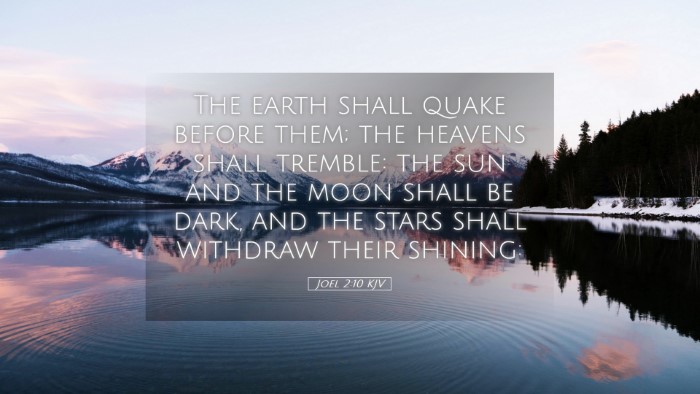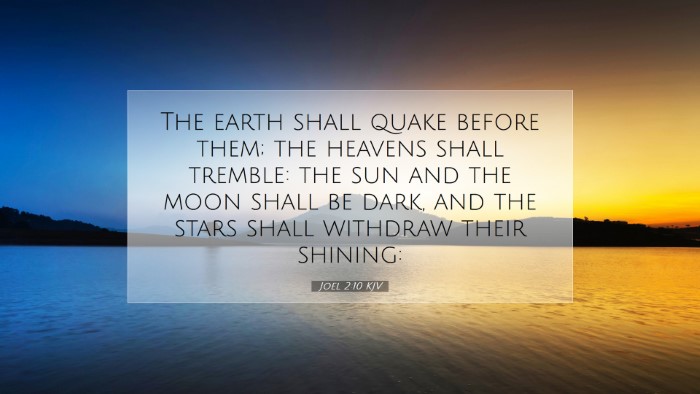Introduction
The prophetic book of Joel presents a vivid image of judgment and divine intervention. Joel 2:10 captures a celestial and terrestrial upheaval that underscores the severity of the impending locust plague and the ultimate day of the Lord. This verse serves as a critical juncture in the prophetic message of Joel, illustrating the consequences of human sin and the overarching sovereignty of God. The insights drawn from the commentaries of Matthew Henry, Albert Barnes, and Adam Clarke collectively enhance our understanding of the themes presented in this text.
Contextual Background
Joel’s prophecy emerges in a time of crisis, driven by a devastating locust invasion that symbolizes God’s judgment against Israel. The devastation prompts a call to repentance among the people. The backdrop of Joel 2:10 is essential for understanding its apocalyptic imagery as it is rooted in a broader narrative of warning and hope.
Verse Analysis
"The earth quakes before them;"
This phrase suggests a profound disturbance in the natural order. As Henry points out, the trembling earth is a manifestation of God’s power, a theophany showcasing His authority over not just Israel but all creation. The consequences of the people's sins provoke such upheaval, showing a direct correlation between spiritual and earthly realms.
"the heavens tremble:"
The trembling heavens amplify the message of divine fury. Barnes illustrates the heavens' reaction as indicative of cosmic disruption. This reflects the biblical theme where celestial bodies symbolize God’s judgment, similar to events depicted in the New Testament, resonating with apocalyptic literature.
"the sun and the moon shall be dark,"
The darkening of the sun and moon signifies a loss of light and guidance, once again reinforcing the theme of divine judgment. Clarke notes that these cosmic events represent not only physical phenomena but also a metaphorical indication of the loss of divine favor, pointing to darkness that envelops a people estranged from God.
"and the stars shall withdraw their shining."
Stars traditionally symbolize hope and guidance. Their withdrawal implies a total eclipse of light, reflecting a state of despair and spiritual dysfunction. Henry discusses how this can be interpreted as a loss of peace and stability, an occasion where God’s protective light is obscured, leaving the people to face the depth of their despair.
Conclusion
Joel 2:10 brings forth a poignant depiction of the magnitude of God's judgment, using rich imagery of cosmic upheaval that resonates through the ages. Public domain commentaries illuminate our understanding of the text, providing insights into divine power, human responsibility, and the intricate dance between judgment and mercy. In a modern context, this verse continues to challenge and inspire those who seek to comprehend both the gravity of sin and the hope provided through repentance and restoration.


